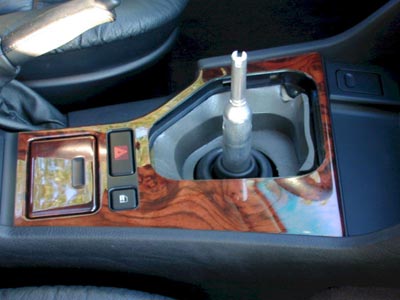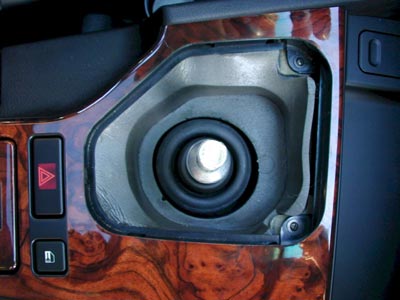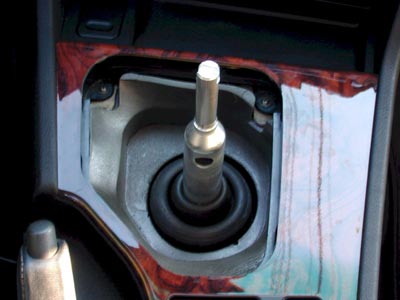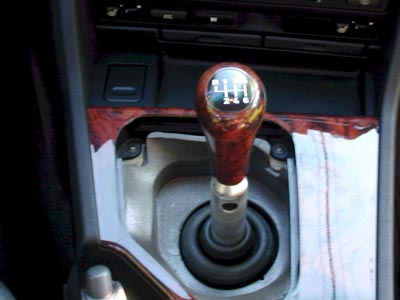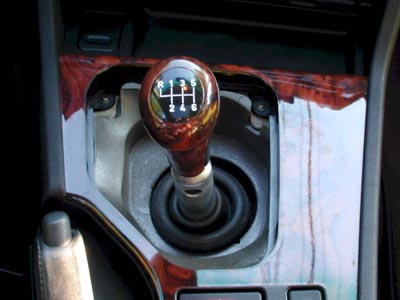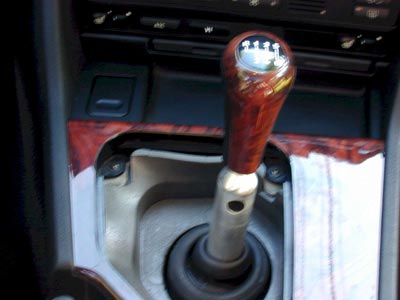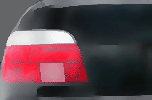

Site Directory
Features
Home
Unique Mods:
- Stealth
V1 Install
- E36
M3 Shifter
- LED
Interior Lights
- Cold
Air Intake
- $2.99
Heat Shield
-
Rear Decal Mount
- Shadowline
Install
- Armrest
Swap
- Clutch
Stop
- Trunk
Handle
- V.60
Phone
All
Mods
"They
all do that..."
(Problems/Fixes)
"RTFM"
(Reference Materials)
Visit
the New BMW
Owner's Self Service Center
Cool
Tools
Pictures
Links
Contact
me at:
mike@540i6.com
New!
Bentley 5 Series
Service Manuals!

Search ebay:
E36 M3 Shifter in an E39 540i
(and info regarding other factory shifters)
Physics 101 ReviewA shifter operates as a simple "Class 1" lever. A longer length at the effort side of the fulcrum (to the right in the diagram below) requires greater movement at that end to yield a given amount of travel at the load end (to the left in the diagram). A longer length at the effort end also results in less effort required to move the load. As the fulcrum is moved toward the effort end, the amount of travel required to move the same load the same distance decreases, but the amount of effort that must be exerted increases. That is, a longer lever yields greater "leverage," and vice versa.
In the case of a shifter, the ball which sits in the carrier for the shifter mechanism acts as the fulcrum. The primary factors determining length-of-throw and shifting effort are the relative lengths of the shifter/lever at either side of the center of the ball. The length from the ball to the lower pivot point where the selector rod pin attaches at the bottom of the shifter is most significant dimension.
(Actually, if viewed as a whole the shifter and link rod act as a compound lever, but for purposes of explanation here addressing only replacing the shifter itself, the above model works.)
General Info re BMW Factory ShiftersFor a good comparison of the lever ratios of various BMW shifters and information regarding how various aspects of the shifters affect throw and effort, discussion of different shifters and applications, installation instructions, etc., see Ron's article here: http://www.unofficialbmw.com//e36/drivetrain/e36_replace_a_shift_lever.html.
As reflected in the article above, it's obvious why the throw in the E39 540 feels so long - because it is! It's also interesting to note that the stock shifter (part number 25-11-1-434-400) is the same as that used in such "beasts" as the E34 and E39 520, the E34 524td, and the E32 730. It's also the same as that used in the E34 535 and M5, and the E38 740, so it does have at least some pedigree.
Typical Factory Shifters used in the E39 540There are several factory shifters that are typically used as replacements for the stock shifter in the E39 540.
The pictures which follow are from Ron Stygar's extensive series of articles at www.unofficialbmw.com. More pictures are here:
http://www.unofficialbmw.com//e36/drivetrain/e36_short_shifter_images.htmlThe shifter that I used is shown below. I pulled it out of my 95 E36 M3. Unfortunately, the exact part shown is NLA. I believe that a basically equivalent shifter with a plastic ball is available as part number 25-11-1-222-955 (but double check that since part numbers change). Retail cost is under $50.
Stock E36 M3 shifterNote that depending on how you search in the ETK, part number 25-11-1-221-977 also is shown as applicable to the E36 M3. This is a standard shifter for various E36 models and is NOT the part that you want. It basically has almost the same dimensions as the stock 540 shifter but is slightly less tall, and will not reduce the throw much if any.
In addition to the E36 M3 shifter, there are several other factory shifters that may be used.
First is the M5 shifter, part number 25-11-2-228-069 (which shares the same part number with the 3.2 E36 M3). It provides about a 25% reduction in throw versus the stock shifter, and has a slightly longer throw and requires somewhat less effort than the M3 shifter above. It seems to be a good compromise for people looking to reduce the throw and not to signifcantly increase effort and "notchiness." It's shown in the picture below.
Stock E39 M5/E36 3.2 shifterSecond is the MZ3 lever, part number 25-11-2-228-384. As shown in the picture below, this shifter in stock form is straight. In order for it to properly center, the lower end of the rod needs to be bent in the same way as the other shifters shown above. Also as can be seen in the picture, the length of the area from the ball to the pivot point is relatively very long, resulting in much more travel of the lower end of the lever for a given amount of movement above. This shifter (bent) commonly is used as an upgrade to the stock E36 M3 shifter. In the E39 540, it will give a MUCH shorter throw than stock, somewhat less throw than the E36 M3 shifter above, and will require greater effort than both.
Stock MZ3 shifter (unbent)
The table below summarizes the characteristics of the above factory shifters on a relative basis.Relative Characteristics of Selected Factory Shifters
for use in the E39 540
Shifter Effort/"Notchiness" Length-of-Throw
The UUC and RE aftermarket shifters have approximately the same dimensions as the E36 M3 shifter, and will give similar results. Also, There are several other factory shifters (e.g., Z3) that could be employed depending on the desired effect.
ApplicationThe pictures below show the E36 M3 shifter installed in my 1997 E39 540i.
Works great. Shifter throw is greatly reduced from the stock boat oar. Length of throw and effort is about the same as the UUC EVO and the original Rogue Engineering (RE) short shifters - about a 35% (?) reduction in throw (all three have approximately the same dimensions). It's nice and quiet. As can be seen in the pictures, it centers well and there's plenty of clearance in every gear.
Centered in neutral - passenger side view. Centered in neutral - top view. Centered in neutral - rear view. Centered in neutral - rear view w/ knob. Reverse 2nd 5th 6th
For comparison, the (bad) pictures below show the stock shifter from the E39 540i (at bottom in both pictures), a 1995 E36 M3 shifter (top in first pic), and the UUC EVO adjustable shifter (top in second pic).
Stock E39 540i versus E36 M3 shifter. Stock E39 540i versus UUC EVO short shifter. The major advantage of using a factory shifter is cost. Also, there are some benefits as far as noise is concerned in the 540 versus solid shaft-type shifters (such as the old B&M) which will transmit relatively more noise and vibration.
The biggest benefit of the aftermarket shifters is that everything comes as a nice kit with all of the little parts that you need (new washers, clip, carrier cup, cup removal tool, etc.), an excellent set of instructions, and great customer service and support. Other benefits include more precise tolerances and improved strength/rigidity of the shifter (although I've not noticed particularly excessive felt play as a result of the rubber buffer), very nice design, machining and appearance (although they really aren't seen once installed), and improved action and alignment as a result of other components sold with the kits such as the RE WSR (however, I'd guess that under normal circumstances maybe one person in ten might be able to detect any difference in feel in a blind test). The UUC, RE, and new B&M shifters all are very nice products.
|
|
|
|
Copyright
© 2002 by M. Andrews. All Rights Reserved.
The information presented on this site describes modifications that
I have made to my car.
Should you choose to attempt any similar modifications, you do so at
your own risk.
This site is not affiliated in any way with BMW NA or BMW AG.
All trademarks, servicemarks, and copyrighted materials that may appear
on this site
are the property of their respective owners.





